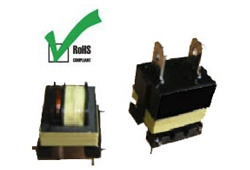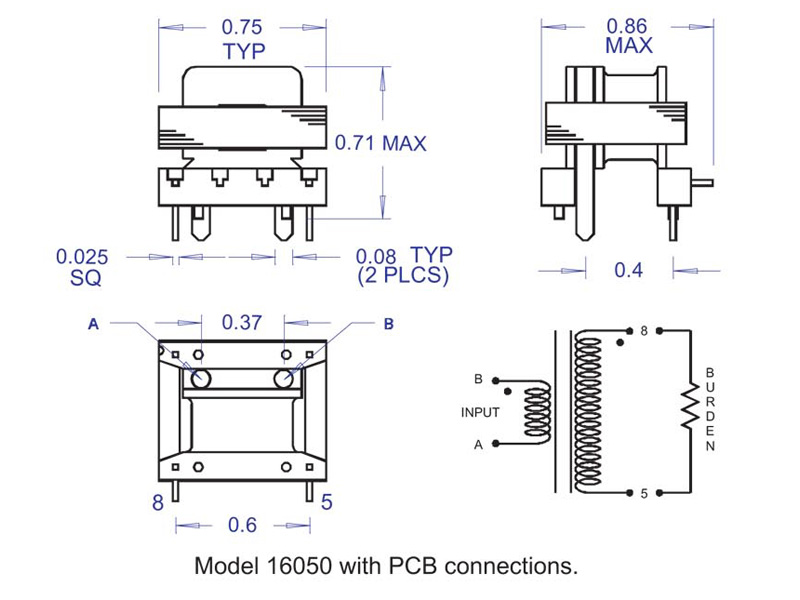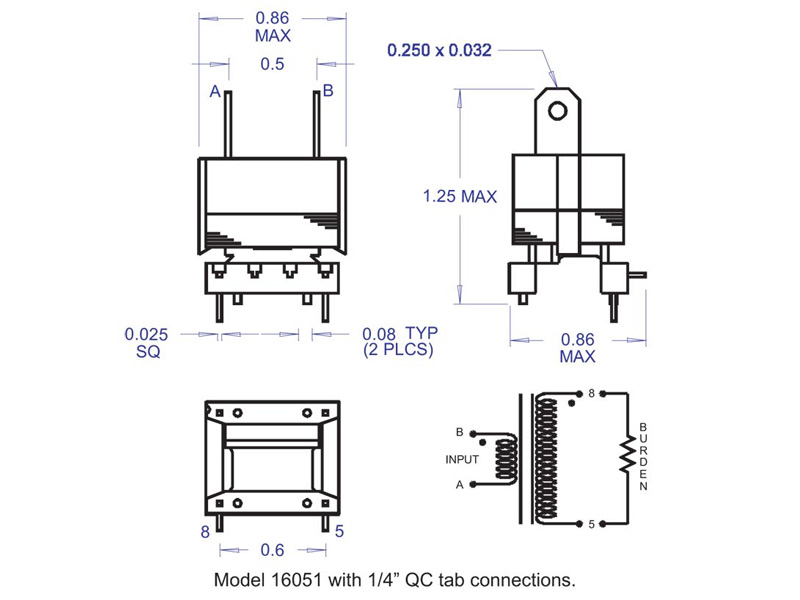Current Transformers
Current transformers represent a unique application of transformer theory.
Unlike power transformers, their purpose is not to change the line voltage up or down to power a piece of equipment. Rather, their purpose is to measure the amount of current passing through a conductor and to isolate this measurement from the source.
This is accomplished by following one of the basic transformer equations which is NpIp = NsIs, or the product of the primary turns multiplied by the primary current equals the secondary turns multiplied by the secondary current.
Whether utilizing a standard EI core or a toroidal core, current transformers generally employ a single turn primary winding and a multi turn secondary winding. Typical turns ratios are 1:500 or 1:1000 indicating that the actual current flowing through the primary winding can be reduced by a factor of 500 or 1000. This makes it practical to measure very large currents in a safe and efficient manner.
Buy Online! We have several standard Current Transformers available for sale online.
Need something slightly different or completely new? We customize! Contact us for more information.
Current transformers are used in conjunction with a burden resistor that is placed across the secondary winding. The current flowing in the secondary winding passes through the burden resistor generating a signal voltage that can be monitored to evaluate system function. The burden resistor is selected based on the maximum voltage the winding can support and the range of currents to be measured. Foster’s Engineering staff can work with you to pick the correct resistor for your application.
Foster’s standard EI core current transformers are ideal for measuring the magnitude of current flowing through a conductor. Unlike a toroidal core transformer, the line or wire being measured does not have to pass through the center of the core. The wire can be broken and attached to either side of the current transformer’s primary winding. This simplifies installation, lowers costs, and makes field repairs simpler because a wire does not have to be cut to remove the transformer or the board to which its connected from the equipment. Our model 16051 goes one step further by providing standard 1/4″ quick connect tabs for the high current connection. This keeps the high current off our your circuit board completely.
If current transformers utilizing an EI core are less costly and simpler to install, why not use them all of the time? The answer is phase shift. The coupling between windings on an EI core is generally not as good as it is with a toroidal current transformer. This results in a phase shift between the voltage and current being monitored. Often this phase shift is unimportant. For applications where it is important to monitor both the magnitude of the current flowing in a conductor and its phase relationship, a toroidal core transformer is often a better solution. If your application requires monitoring both the phase and magnitude of the current passing through a conductor, consult Foster for a custom solution.
Standard Current Transformers
- Rated Current: 0.1 A – 30.0 A.
- Operating Frequency: 50 Hz – 400 Hz.
- Turns Ratio: 1:500.
- Typical Output: 100 mV/Ampere.
- Suggested Burden Resistor: 50 Ohms.
- Primary Resistance: 0.011 Ohms, typ.
- Secondary Resistance: 16.7 Ohms, typ.
- Dielectric: 500 V, RMS.
- UL Class 130 (B) materials.
- Optional 1/4″ quick connect terminals for high current connection.
Applications
Current Transformers are used in a wide variety of industrial and commercial applications. Some of the more common applications include:
- Monitoring Equipment
- Gas Appliances
- Load Sensing
- Motor Control
- UPS Systems
Don't see what you're looking for?
We have over 20,000 transformer designs available




